
When I was a child, one of my favorite action movies was the James Bond classic Goldfinger. The movie’s plot centers on the corrupt businessman Auric Goldfinger and his plan to steal the gold from the bullion depository at Fort Knox. However, the villain’s obsession with precious metal is ended when his plan is foiled by Bond. Similar to Goldfinger, I have an insatiable appetite for gold, which is wetted by our upcoming Fine & Decorative Arts Including Estates Signature Auction. We offer several lots featuring gold elements in design and form, which will only steal attention—far less criminal than robbing Fort Knox.
Lot 63181: A Moorish Revival Mahogany and Gilt Bronze Mantle Clock for Tiffany & Co.
 In the mid to late 19th century, advances in transportation, in conjunction with packaged tours, offered a wider range of Americans access to Middle Eastern historical sites. In addition, the availability of Arabesque imagery contained in books and stereoscopes encouraged the trend’s visibility among those not wealthy enough to travel overseas. This clock, retailed by Tiffany and Co, features gold embellishments contrasting against a mahogany case in an elegant and stated aesthetic. The onion-bulb finials and dome on this clock reflect America’s fascination with Moorish design. The design also resonates with American tastes in revival styles, with the inclusion of Gothic trefoils and tracery, along with Corinthian order capitals. The gilt clock face is expertly damascened with radiating acanthus leaf designs around the key holes for the mechanism’s three double-fusee driven barrels. The clock is fitted with the unusual and innovative alternating Westminster/Whittington movement that master clock maker, Joseph Lindauer, patented in 1882 for Tiffany & Company. A similar tall case example resides in the Metropolitan Museum of Art, accession no. 06.1206. A shorter specimen like this has never been offered to the contemporary market.
In the mid to late 19th century, advances in transportation, in conjunction with packaged tours, offered a wider range of Americans access to Middle Eastern historical sites. In addition, the availability of Arabesque imagery contained in books and stereoscopes encouraged the trend’s visibility among those not wealthy enough to travel overseas. This clock, retailed by Tiffany and Co, features gold embellishments contrasting against a mahogany case in an elegant and stated aesthetic. The onion-bulb finials and dome on this clock reflect America’s fascination with Moorish design. The design also resonates with American tastes in revival styles, with the inclusion of Gothic trefoils and tracery, along with Corinthian order capitals. The gilt clock face is expertly damascened with radiating acanthus leaf designs around the key holes for the mechanism’s three double-fusee driven barrels. The clock is fitted with the unusual and innovative alternating Westminster/Whittington movement that master clock maker, Joseph Lindauer, patented in 1882 for Tiffany & Company. A similar tall case example resides in the Metropolitan Museum of Art, accession no. 06.1206. A shorter specimen like this has never been offered to the contemporary market.
Lot 63432: A Set of Three Chinese Export Grisaille Plates Depicting Life of Christ, after Jan Luyken
This series of incredibly rare plates, produced in China for the Dutch market, illustrates the Western market demands on the porcelain producing East. The group of three depict the Nativity, Crucifixion, and Resurrection/Ascension of Christ. The designs reflect the growing availability of printed matter, each being interpreted from an early eighteenth century Lutheran bible with prints by the Amsterdam poet and engraver Jan Luyken (1649-1712). The set dates to around 1745 and was illustrated with a fine black painting technique colloquially known as en grisaille (grey in color), and features gilt embellishments to the central illustrations. A single plate depicting Luyken’s engravings is hard to find, and to have a set of three is truly exceptional. Also included in this sale is a period portraiture plate of Martin Luther (Lot 63430) and a rare Neoclassical themed octagonal plate (Lot 63431).
Lot 63482: A Japanese Toba Sojo-Style Shinoware Scenic Vase with Skeletons, Octopi, and Buddha
Full disclosure: This is my favorite piece in the sale. The vase is a seldom seen form of Japanese earthenware known as shinoware. Shino glazes are characterized by speckled glazing and scattered holing to the vessel’s surface. This holing is caused by the inclusion of soda ash, which causes carbon to be trapped in the glaze, creating the spots and dimples during the firing process. This technique gives the piece an extra element of depth and imitates the aesthetic of lava rock. The vase’s decoration is surreal: clothed octopi, skeletons, frogs, a sea turtle, and a resting Buddha. The resting Buddha is phenomenal as its flowing garments serve as an illusion of ocean waves drowning several skeletons. Each figure is highly detailed with colorful and intricate glazes. The neck, ground, and animal figures all feature gilt embellishments. The illustrations are borrowed from two well-known Japanese artists, Toba Sōjō (1053–1140) and Utagawa Kuniyoshi (1797-1861) with most of the influence drawn from the latter.
Lot 63049: A French Gilt Bronze Figural Centerpiece and Mirrored Plateau
This ormolu gilt centerpiece and mirrored plateau combines elements of the Rococo and early Art Nouveau periods to create a stunning tabletop masterpiece. This specific ormolu technique utilizes a high-carat gold and mercury amalgam application. The object is heated in a kiln, evaporating the mercury, leaving a gold veneer to the surface. The plateau features Rococo-style shell and scrolled legs with intricate foliate and floral decoration to the scalloped edge and handles. The centerpiece itself contains wonderful representations of the Art Nouveau female aesthetic, with elongated semi-nude bodies, flowing garments, and windblown hair. The figural handles are simplistic in the conveyance of movement, in contrast to the overstated Rococo-style scrolling elements of the body. A central cartouche to each side features a reclining nude woman and putto in low relief. The centerpiece is a commanding and high-quality representation of the inclusive and progressive nature of French decorative arts in the 19th century.
By Nathan Shults





Leave a Comment